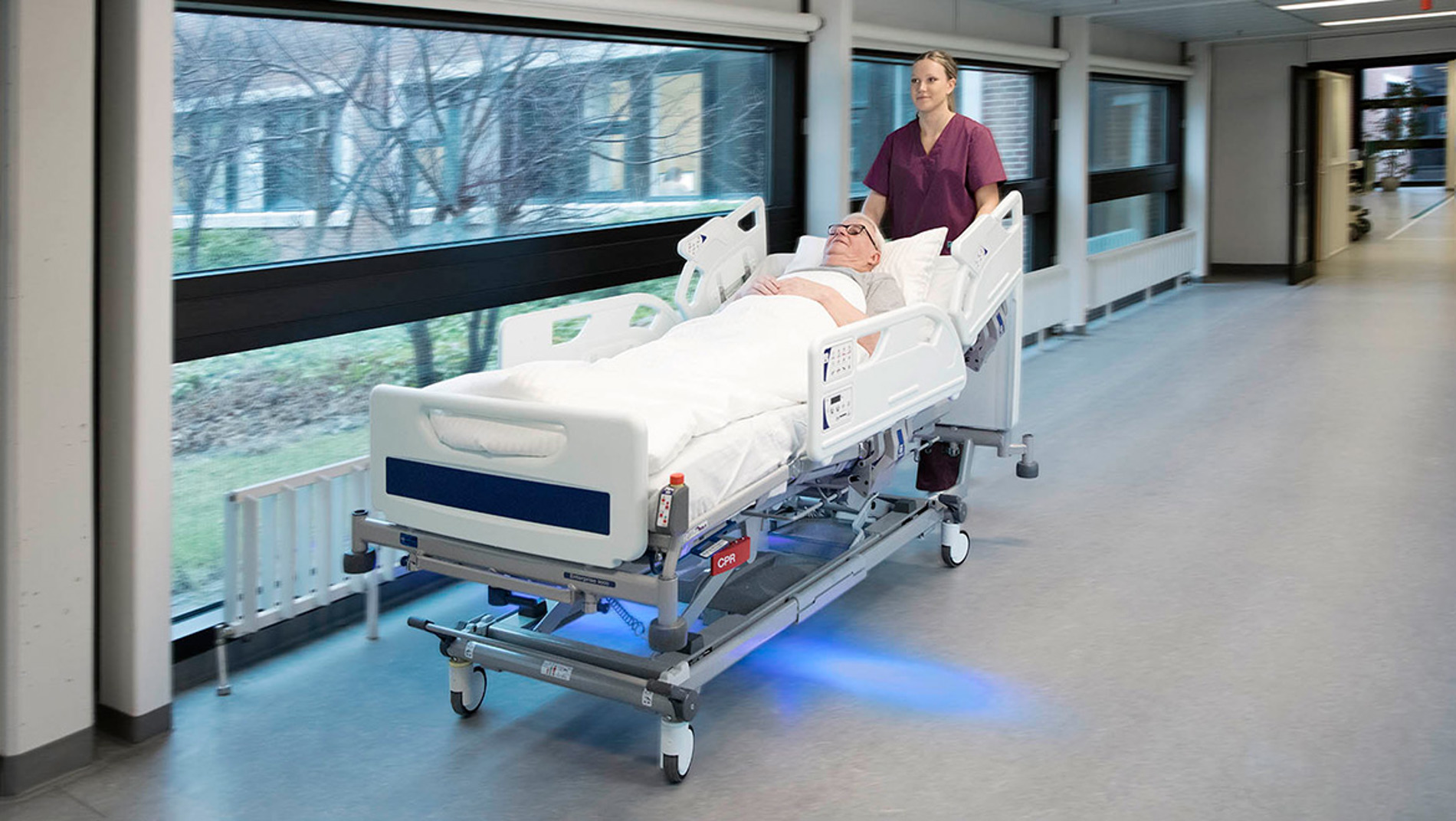What technologies are used to aid caregivers in transporting patients on hospital beds?
There are different types of power assisted transport technologies used with hospital beds that help caregivers reduce effort in transporting patients throughout the facility.

The following is an extract from a whitepaper 'The case of powered bed transport' which discusses available technologies:
Pushing a modern hospital bed with a patient in it can be heavy, strenuous work. Additional challenges may also include narrow corridors, inclines, soft floorings, elevators and long distances between departments. To reduce the risk of work-related injuries and help increase efficiency, a number of assistive devices, including separate bed movers, are available. These, however, can be impractical and difficult to operate.
"To reduce the excessive ergonomic effort and risk of injury when transporting patients, adaptations have been made to standard beds adding power features and fifth wheels. Battery-powered bed pushing devices have also been designed to assist in bed transport. 39-44 Each has their benefits and challenges:
Robotic hospital bed mover: a button controlled movable 'Fork lift' attachment device for beds.
"A robotic hospital bed mover with omni-directional mobility demonstrated better performance than use of a manual transport stretcher. It was estimated that the robotic device halved the force required to push hospital beds, reducing physical demands, requiring less manpower, and reducing back muscle activities 47.
Steering Assistance
Steering assistance features such as a 5th wheel design are perceived to improve caregiver productivity during patient transportation tasks within a patient room and when moving down a corridor 48.

Power Drives
Power drives, are used to facilitate movement of hospital beds. Wiggermann (2017) conducted a study that measured hand forces on 10 caregivers while they moved a bariatric bed manually and while using a powered drive. The powered drive decreased peak forces between 38% (while maneuvering into an elevator) and 94% (while going down a ramp). The powered drive also reduced stopping distance by 55%. During straight-line pushing, average hand forces did not vary between bed designs but when maneuvering the bed, the force was reduced by 34% when using powered drive beds" 49.

IndiGo intuitive drive assist
For hospitals looking to reduce ergonomic risk and support efficient workflows, IndiGo is the powered fifth wheel that aims to offer a helping hand in order to make every transport as safe, controlled and simple as possible.
References:
[39] Department of Veterans Affairs (VA), Center for Engineering and
Occupational Safety and Health (CEOSH). Safe Patient Handling and Mobility
Guidebook. (2016). St. Louis, MO.
[40] J+J Flooring Group. Flooring Selection for Acute Care Facilities: Safety
Implications. ND. https://www.jjflooringgroup.com/wp-content/uploads/Safety_
Technical_White_Paper_FINAL.pdf.
[41] International Organization for Standardization (ISO).
Ergonomics — Manual handling of people in the healthcare sector. Reference number ISO/TR 12296:2012(E). 2012.
[42] Matz, M. (2010). Rationale for Including the PHAMA in the 2010 Guidelines for Design and Construction of Health Care Facilities. In Borden, C.(Ed), Patient Handling and Movement Assessments: A White Paper. Dallas:The Facilities Guidelines Institute.
[43] Menzel, N.N. Strengthening your evidence base: Focus on safe patient.
American Nurse Today, 5(7):38-40. (2010) Retrieved February 11, 2018 from
https://www.americannursetoday.com/strengthening-your-evidence-base-focuson-safe-patient-handling/.
[44] Kim, S., Barker, L.M., Jia, B., Agnew, M.J., Nussbaum, M.A. Effects of two hospital bed design features on physical demands and usability during brake engagement and patient transportation: a repeated measures experimental study. Int J Nurs Stud. 2009 Mar;46(3):317-25.
[47] Guo, Z., Yee, R.B., Mun, K.R. & Yu, H. Experimental evaluation of a novel robotic hospital bed mover with omni-directional mobility.
Appl Ergon. 2017 Nov;65:389-397.
[48] Kim, S., Barker, L.M., Jia, B., Agnew, M.J., Nussbaum, M.A. Effects of two hospital bed design features on physical demands and usability during brake engagement and patient transportation: a repeated measures experimental study.
Int J Nurs Stud. 2009 Mar;46(3):317-25.
[49] Wiggermann, N. Effect of a powered drive on pushing and pulling forces when transporting bariatric hospital beds. Appl Ergon. 2017Jan;58:59-65.


